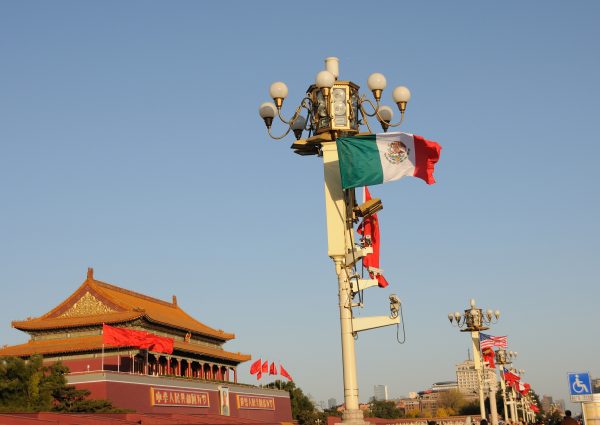China’s application was presented to the CPTPP Commission the same day that the United States, the United Kingdom and Australia announced AUKUS — a security alliance that unabashedly seeks to bring about a new balance of power in the Pacific.
This was also the rationale for the design of the Trans-Pacific Partnership (TPP), an agreement predicated on former US president Barack Obama’s statement that ‘the United States is a Pacific power and we are here to stay’. In both cases, the underlying purpose was to counter the strides that China was making to gain military and strategic supremacy in the region.
Although it may take years to materialise, accession to the CPTPP would permit Beijing to be part of a regional arrangement that was originally intended to counter its power in the Pacific. It would also open the possibility for China to fill the power vacuum left by the withdrawal of the United States from the TPP in 2017.
Beijing could profit from the closer economic integration the CTPPP is likely to generate among its member countries which, in the absence of Washington, would probably slide towards China’s economic and political sphere. CPTTP membership would simultaneously enable Beijing to deepen its economic and political ties with the pact’s Latin American members and with Latin America at large.
Those ties were significantly strengthened with the creation of the China–CELAC Forum in July 2014. The Community of Latin American and Caribbean States (CELAC) is an intergovernmental mechanism which was established in 2010 for dialogue and cooperation among the 33 nations of Latin America and the Caribbean.
Membership of the CPTPP would widen the possibilities for China to tap into this market of more than 652 million people and a region rich in natural resources with a myriad of greenfield investment opportunities. It would also provide a huge potential to expand trade links and build supply chains led by Chinese companies.
China’s membership would be beneficial for Latin America as well. China is South America’s top export market and the second for Latin America and the Caribbean as a whole. Among China’s top 100 trading partners, 13 are Latin American and Caribbean countries. Chinese exports to these countries topped US$142 billion in 2020 — 5.5 per cent of China’s total exports.
With the exception of Asia’s main trading destinations, China’s exports to Mexico are larger than those to any other East Asian economy, including Australia. Three of China’s top 25 import-originating countries are Latin American — Brazil, Chile and Mexico.
It can then be expected that Latin American members will welcome China’s incorporation into the CPTPP — in principle, the same could occur if Taiwan is accepted, although in this case Latin American governments might be more cautious so as to not compromise their support for China. Besides the likely economic benefits, the presence of China would counter the weight and influence the US would command should the Biden administration decided to join in and thus bring about a more balanced power play within the pact.
The Latin American country that would give China the warmest welcome is Mexico, especially given the openly anti-US stance Mexican president Andres Manuel Lopez Obrador has adopted since Biden took office, Mexico’s membership in the US–Mexico–Canada Agreement (USMCA) notwithstanding. In fact, visible signs of mutual empathy have been sent from both sides. At the 2021 CELAC summit meeting held in Mexico City on September 18, two world leaders were invited as keynote speakers — Chinese President Xi Jinping (the first to speak) and UN Secretary General Antonio Guterres. Two days before, Xi had sent a warm congratulatory message to Lopez Obrador to mark the 200th anniversary of Mexico’s independence.
On those bases, Xi could cultivate a closer relationship with Lopez Obrador by building on his anti-US stance and thus gain a valuable ally. Beijing could find friendly ground in a country that shares a 3145-km border with China’s rival in the new cold war that is unfolding nowadays.
If Biden decides to join the CPTPP, Washington would surely do what it could to make Beijing’s accession difficult. One way of doing this would be to press Canada and Mexico to force China to satisfy more and harder-to-meet requirements. Another would be to invoke the USMCA’s Article 32.10.5, the so called ‘poison pill’ clause, and threaten to walk away from the agreement.
Mexico and Canada signed the CPTPP in March 2018 and the USMCA eight months later. If China were accepted to the CPTPP, neither would be signing a new agreement with a ‘non-market’ economy but simply abiding China’s admission into a multi-country trade agreement of which they happen to be members already.
If the ‘poison pill’ were invoked, then Canada or Mexico would have to agree on exiting the USMCA and promptly sign a bilateral pact with the United States. This seems highly unlikely given the strong trade links among these three countries and the deeply entrenched continental supply chains they share.
Juan J Palacios is Professor at the Centre for Strategic Development Studies, University of Guadalajara, and a member of the PAFTAD International Steering Committee.


Canada should refuse access to both the US and China as neither country live up to its commitment in trade deals. The US is not a trust worthy partner and uses their legislation to block trade ( ie softwood lumber, steel and aluminium as well as buy American provisions) and when they lose in even their own courts, they tinker with the law and reimpose duties then we have to start over taking years to win again. China is also untrustworthy. They simply ignore rules and if you make to much fuss, they arrest your citizens on trumped up charges or simply do what they please.
I would favour allowing UK and Taiwan in though. Both respect rules and human rights.